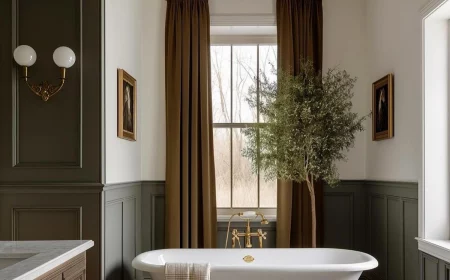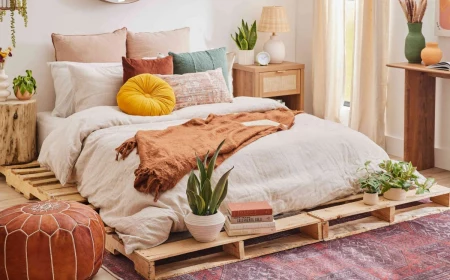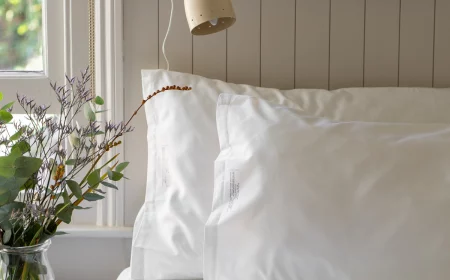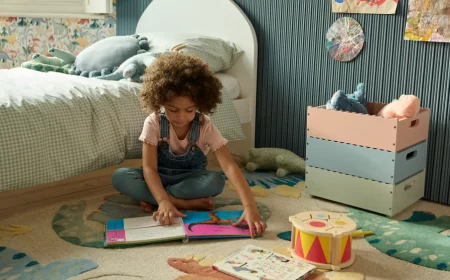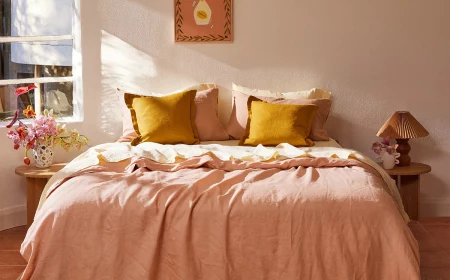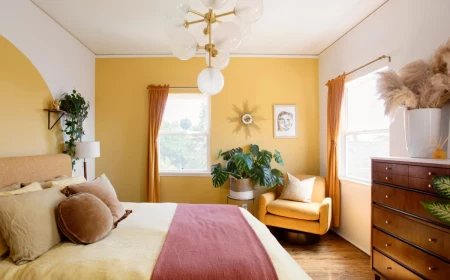Stop Buying the Wrong Duvet Cover: Your Guide to a Better Night’s Sleep
I’ve worked with textiles for years, from outfitting fancy hotels to helping friends pick out their first set of ‘adult’ bedding. And through it all, I’ve seen the same mistake over and over again. People will research a mattress for weeks, but then grab a duvet cover in five minutes because they like the color. Let’s be real: your duvet cover is the part of your bed you actually touch all night. Its feel and material have a massive impact on how well you sleep.
In this article
Think of it this way: a duvet cover isn’t just a big, decorative pillowcase for your comforter. It’s a functional piece of gear. It needs to manage your temperature, deal with moisture, and feel good against your skin. Getting it right is the difference between a truly restful night and just… being in bed.
This guide is packed with everything I’ve learned—both the wins and the expensive mistakes. We’re going to look past the pretty patterns and get into what actually makes a duvet cover worth your money.
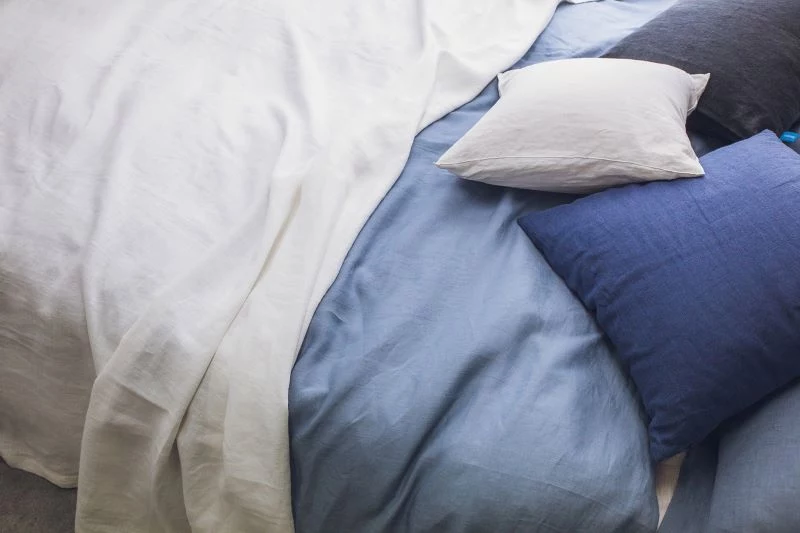
First Things First: It’s All About the Fiber
Before we even get to words like ‘percale’ or ‘thread count,’ we have to start with the raw material. The fiber is the building block, and it dictates almost everything: breathability, softness, durability, and price. Choosing the right one is the single most important step.
Cotton: The Old Faithful
Cotton is the king of bedding for a reason. It’s breathable, generally soft, tough, and won’t break the bank. But here’s the catch: not all cotton is the same. The real difference comes down to fiber length, or what the pros call “staple.”
- Long-Staple & Extra-Long-Staple Cotton: This is the good stuff. We’re talking about varieties like Pima and true Egyptian cotton. The long, smooth fibers create yarns that are both stronger and much softer. A duvet cover made from this will resist pilling (those annoying little fuzzballs) and feel incredible for years.
- Upland Cotton: This is your standard, short-staple cotton. It’s what most affordable cotton products are made of. It works, but it’s not going to feel as luxurious and can get a bit coarse over time as the shorter fibers start to break.
Heads up! The term “Egyptian Cotton” gets thrown around a lot. True Egyptian cotton is a specific extra-long-staple variety grown in a particular region, but the label isn’t always policed well. A high price tag doesn’t automatically mean it’s the real deal. I always look for an OEKO-TEX or GOTS certification to feel more confident in the quality.
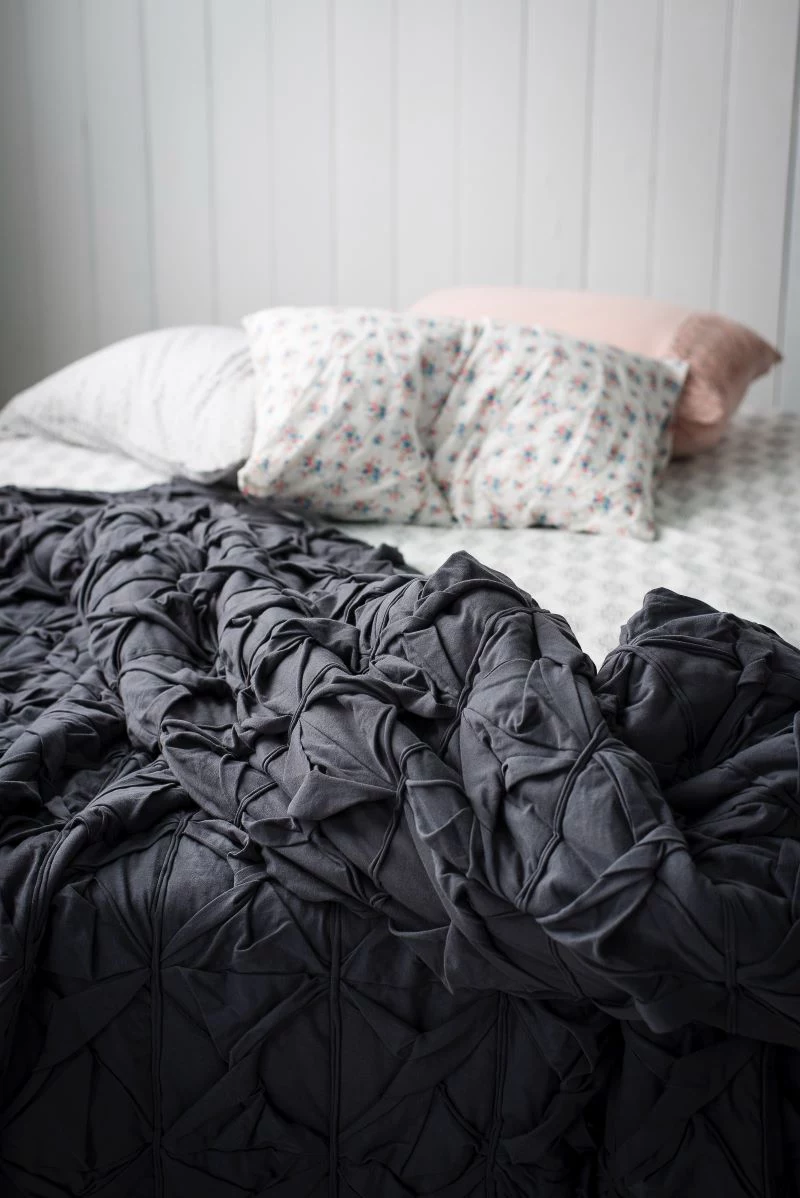
Linen: The Effortless, Rumpled Beauty
Linen, made from the flax plant, is one of the oldest and most interesting textiles out there. It has a unique personality—it’s incredibly breathable and a rockstar at regulating temperature. It’ll keep you cool on a hot night but also feels surprisingly cozy in the winter. The magic of linen is that it gets better with every single wash, becoming softer and more supple over time.
But let’s be honest: linen wrinkles. A lot. If you’re someone who needs a perfectly smooth, hotel-style bed, linen will make you crazy. For others, that relaxed, rumpled look is the whole point. It’s also usually pricier than cotton because it’s a bit more work to produce.
Tencel (Lyocell): The Silky Smooth Innovator
Tencel is a brand name for lyocell, a fiber made from sustainably sourced wood pulp, usually from eucalyptus trees. It’s known for being an eco-friendly choice. But the real reason people fall in love with it is the feel. Tencel is wildly smooth and silky, with a heavy, luxurious drape. It also has a distinct cool-to-the-touch sensation and is even more absorbent than cotton, which is fantastic for hot sleepers.
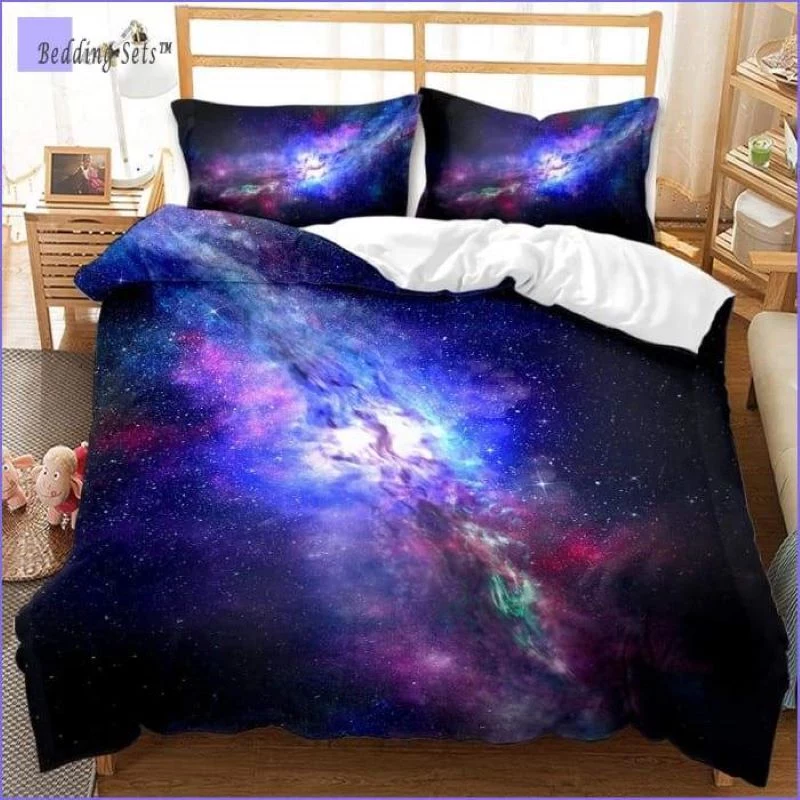
The trade-off? You have to be a bit more careful with it. I always tell people to wash Tencel on a cold, gentle cycle and dry it on the lowest heat setting. High heat can damage the fibers and make them feel rough over time.
Bamboo: The Softer Cousin
You’ll see a lot of bamboo bedding out there, and it’s quite similar to Tencel in feel. It’s often sold as bamboo viscose or rayon. It’s super soft, drapes beautifully, and is great for wicking away moisture. Just like Tencel, it requires gentle care in the wash to maintain that silky texture.
Jersey: Your Favorite T-Shirt for Your Bed
Exactly what it sounds like! Jersey is a knit fabric, not a woven one, usually made of cotton or a cotton blend. It’s soft, stretchy, and super casual. It feels like sleeping in your most comfortable old t-shirt. It doesn’t wrinkle much, which is a big plus. However, it’s not as durable or crisp as a high-quality woven cotton, and it can sometimes stretch out of shape.
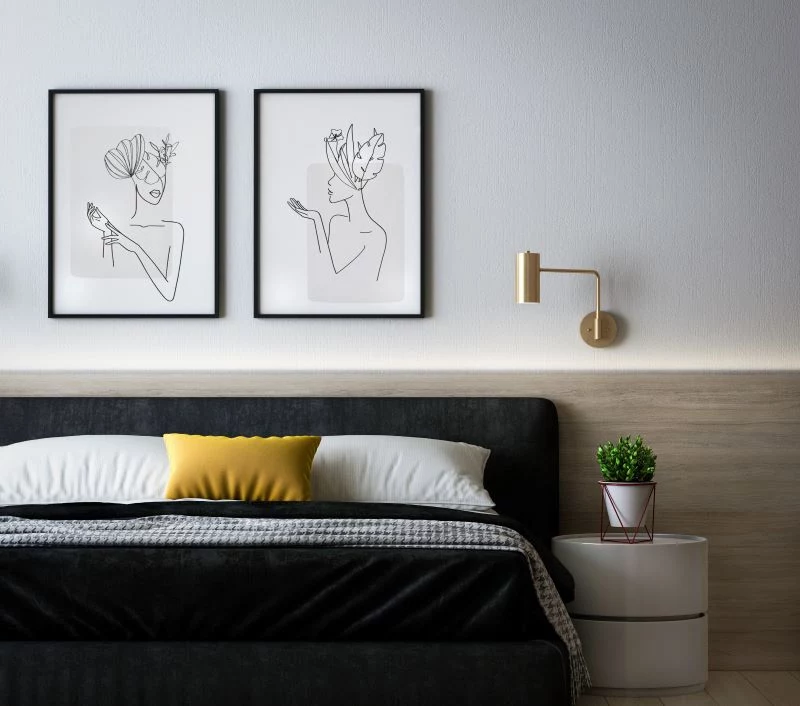
Microfiber (Polyester): The Budget Go-To
Microfiber duvet covers are everywhere, mostly because they are incredibly cheap. They are also wrinkle-resistant and hold onto dye really well, so the colors stay vibrant. But I rarely recommend them if comfort is your top priority.
The biggest problem is breathability. Polyester is basically plastic, so instead of absorbing sweat, it traps it against your skin. This can leave you feeling clammy and hot. While it feels soft in the package, it just doesn’t perform well overnight.
The Weave: How It All Comes Together
Okay, so you’ve picked a fiber. Now, how is it woven? The same high-quality cotton can be used to make two totally different fabrics, each with its own vibe.
Percale: Crisp, Cool & Matte
Percale is my personal favorite. It’s made with a simple one-over, one-under weave that creates a fabric that’s light, airy, and crisp—think of a classic, high-end hotel bed. It has a matte finish and feels incredibly refreshing to slip into, especially if you tend to sleep hot. It does wrinkle more than sateen, but taking it out of the dryer while it’s still just a little damp helps a ton.
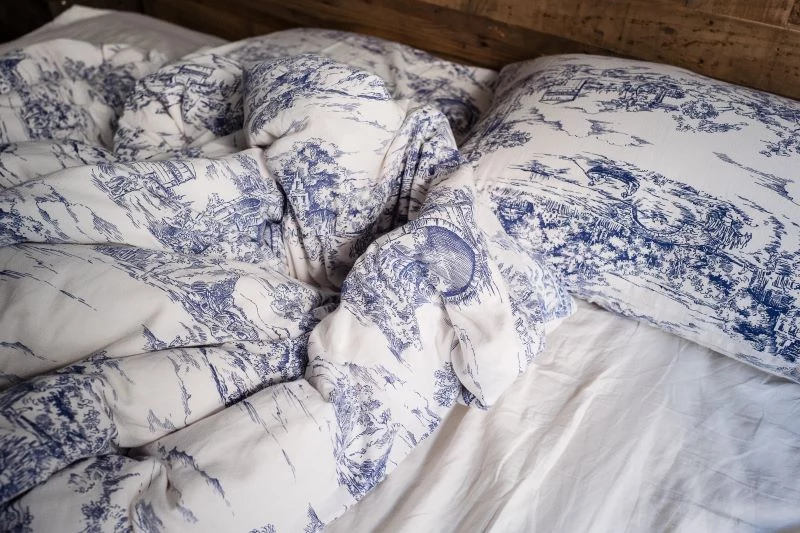
Sateen: Silky, Smooth & Shiny
Sateen uses a different weave—more like one-under, three or four-over. This exposes more of the thread’s surface, resulting in that signature silky-smooth feel and a subtle sheen. It drapes beautifully and feels warmer and cozier than percale, making it a great choice for people who get cold at night.
A heads-up for pet owners: This is where weave really matters. The tight, flat weave of percale is more durable against claws and makes it way easier to brush pet hair off. The looser, exposed threads of sateen, on the other hand, can be a total snag magnet for cats and dogs.
Flannel: Cozy, Fuzzy & Warm
Flannel isn’t so much a weave as it is a finish. The fabric, usually cotton, is brushed to lift up the fibers, creating a fuzzy surface with millions of tiny air pockets. These pockets are fantastic insulators, trapping your body heat to keep you toasty. When you’re shopping, look for the weight, usually measured in grams per square meter (GSM). Anything over 170 GSM will feel substantial and cozy.
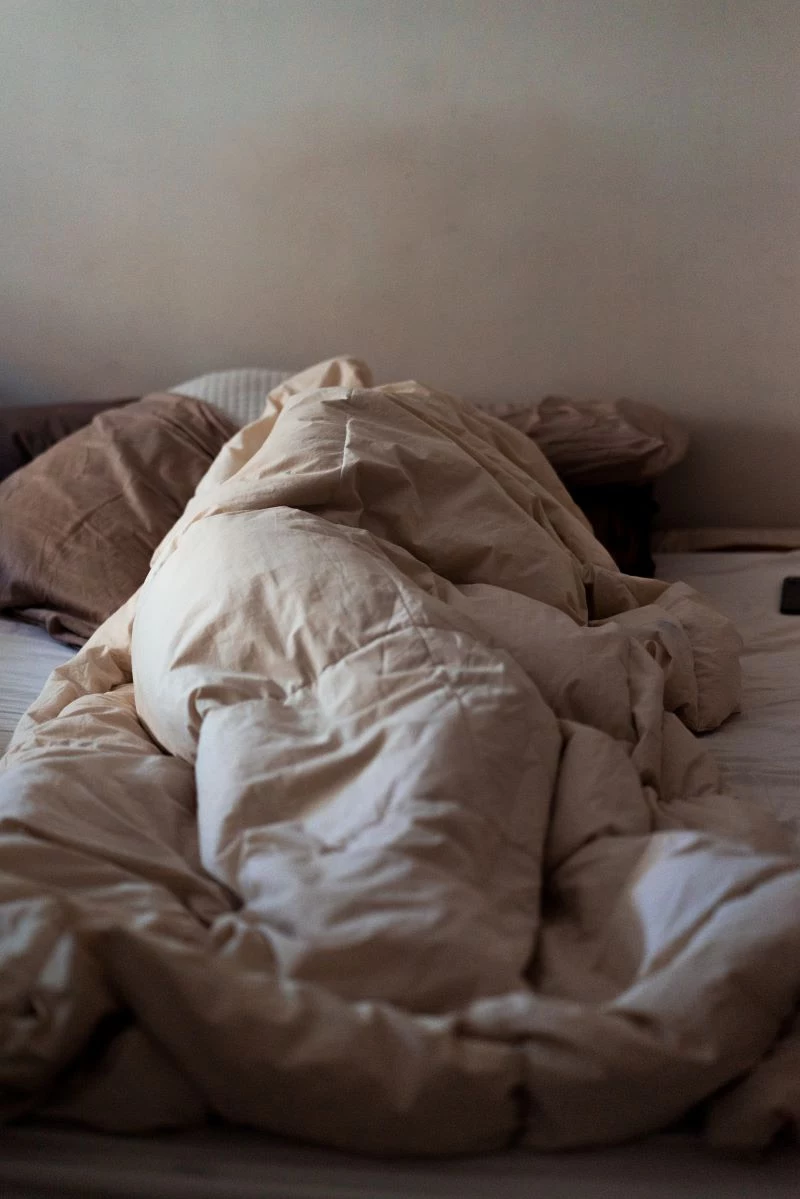
The Little Details That Make a Big Difference
These are the things that separate a cheap duvet cover from one that will make you happy for years.
The Thread Count Myth
Forget what you’ve heard. A higher thread count does NOT automatically mean better quality. It’s just the number of threads in a square inch. Some companies cheat by using thin, weak multi-ply yarns to inflate the number. A 300-thread-count cover made from strong, single-ply, long-staple cotton will feel a thousand times better and last longer than a 1,000-thread-count cover made from cheap, short-staple cotton. Honestly, for quality cotton, the sweet spot is usually between 200 and 500. Focus on the fiber quality first!
Closures & Corner Ties
This is a big one. How does the cover close, and how does it keep the duvet insert from becoming a lumpy mess in the middle of the night?
- Internal Corner Ties: This is non-negotiable for me. Look for a cover that has fabric ties stitched into the four inside corners. You use these to tie your duvet insert in place, and it’s a total game-changer. If a cover doesn’t have them, I don’t buy it. Simple as that.
- Closures (Buttons vs. Zippers): Buttons look classic but can be a pain on laundry day. Zippers are fast and create a clean line, but a cheap one is a liability. I once bought a cover with a flimsy plastic zipper that broke after the third wash. A duvet cover with a broken zipper is basically just a very expensive, frustrating sheet. Now, I always look for a sturdy metal zipper or stick with securely stitched buttons.
One Quick Thing to Check Before You Buy
Here’s a lesser-known trick: If you have a dark-colored or patterned duvet insert and you’re buying a light-colored cover (especially linen), hold the fabric up to the light. You’d be surprised how often the pattern on the insert can show through a thin or light-colored cover!
How to Actually Get the Duvet Inside (Without Losing Your Mind)
Ah, the age-old struggle. Here’s the easiest way, I promise. It’s called the ‘Burrito Method’.
- Turn your duvet cover completely inside out and lay it flat on your bed. The opening should be at the foot of the bed.
- Lay your duvet insert right on top of it, making sure all the corners line up.
- Now, tie the corner ties. This is the most important step!
- Starting from the head of the bed, roll the cover and insert together like a giant burrito.
- When you get to the end, reach into the opening, grab one end of the burrito, and stuff it inward, flipping the cover right-side out over that corner. Do the same on the other side.
- Then, just unroll the burrito back toward the head of the bed. It will unroll perfectly. Give it a shake, zip it up, and you’re done!
Finding Your Perfect Match: Budget to Heirloom
So, what should you expect to pay? A cheap polyester cover might be $40 at a big box store. For that sweet spot—a really great quality long-staple cotton or Tencel cover—expect to pay around $120 to $250 from a good direct-to-consumer brand. And for true heirloom quality, like premium European linen, you can easily spend over $400.
You don’t have to spend a fortune, but it’s good to know where to look:
- Budget-Friendly: You can find some surprisingly good options at places like Target (their Casaluna line is often a solid choice) or online from retailers like Quince, which focus on quality basics at a lower price point.
- Mid-Range Sweet Spot: This is where most of the popular online brands live. Think Parachute or Brooklinen. They offer fantastic quality, great materials like long-staple cotton and linen, and a good balance of price and durability.
- Luxury & Heirloom: For those who want the absolute best and are willing to invest, brands that specialize in premium textiles are the way to go. These are the kinds of covers that can genuinely last for decades if cared for properly.
Ultimately, choosing a duvet cover is about your personal priorities. Are you a hot sleeper who needs something crisp and cool? Go for percale or linen. Do you crave that silky, five-star hotel feeling? Sateen or Tencel is your answer. In the end, this piece of fabric is going to be your companion for thousands of hours. Choose it with a little care, and it’ll pay you back every single night.
Inspirational Gallery
Tired of your duvet insert bunching up into a lumpy mess?
The fix is simpler than you think. Most quality duvet covers, like those from Quince or The Company Store, come with small fabric ties sewn into the interior corners. Before closing the cover, make sure to securely fasten each of these ties to the corresponding loops on your duvet insert. This small step keeps everything perfectly aligned, ensuring an even, cloud-like bed every night. No more midnight wrestling matches with your bedding!
More than 90% of our interaction with bedding is tactile. The way it feels against our skin directly influences our body’s ability to relax and enter deep sleep cycles.
This is why the weave of the fabric is just as crucial as the fiber itself. A sateen weave, for example, will feel silky and smooth, draping over the body, while a percale weave is crisp and cool, reminiscent of classic hotel sheets. Your personal preference for texture is a key component of your sleep comfort.
Percale: Imagine a freshly-ironed dress shirt. That’s percale. It’s a plain, matte weave that feels light, crisp, and exceptionally breathable. It’s the top choice for hot sleepers or those who love a clean, cool-to-the-touch sensation. Brands like Parachute have built their reputation on this classic, airy feel.
Sateen: This weave has more threads on the surface, creating a silkier, smoother feel with a subtle sheen. It’s slightly heavier and warmer than percale, making it cozy for cooler nights. If you prioritize a luxurious, drapey look and a buttery-soft touch, look to Brooklinen’s popular sateen offerings.
Don’t overlook the closure type, as it affects both function and style. A hidden zipper closure offers a clean, seamless edge and is very secure. On the other hand, button closures, often made from natural materials like wood or mother-of-pearl, can add a rustic or traditional design element. Consider which look best suits your bedroom’s aesthetic.
- It gets softer and more comfortable with every single wash.
- It’s naturally thermoregulating, keeping you cool in summer and warm in winter.
- It has a relaxed, effortlessly chic look that doesn’t require ironing.
The secret? 100% European Flax Linen. Unlike cotton, linen fibers are long and durable, meaning they don’t break down but rather soften over time, making a quality linen duvet cover from a brand like Cultiver or MagicLinen a true long-term investment in comfort.
Looking for luxury on a budget? Consider a high-quality cotton-linen blend. These duvet covers, often available from retailers like H&M Home or Zara Home, provide much of the desirable relaxed texture and breathability of pure linen but at a significantly more accessible price point. You get the best of both worlds: the durability of linen and the familiar softness and lower cost of cotton.
The production of TENCEL™ Lyocell fibers, derived from sustainably sourced eucalyptus wood, uses a closed-loop process that recycles over 99% of the water and solvents used.
This makes fabrics like TENCEL™ an increasingly popular choice for the eco-conscious sleeper. Beyond its green credentials, a TENCEL™ duvet cover, like those made famous by Buffy, is known for its incredible softness, silky feel, and exceptional moisture-wicking properties, often described as feeling cooler than cotton.
- Always wash your duvet cover inside out to protect the color and fibers from abrasion in the machine.
- Avoid fabric softeners. They can leave a coating on natural fibers like cotton and linen, reducing their natural breathability and absorbency.
- If possible, tumble dry on a low heat setting and remove it while it’s still slightly damp to prevent over-drying and minimize wrinkles.
Embrace the Scandinavian art of ‘hygge’ by layering textures. Instead of a perfectly matching set, try pairing a stone-washed linen duvet cover in a muted earth tone—think oatmeal, slate grey, or dusty rose—with different textured pillows. The beauty is in the imperfection; a slightly rumpled, lived-in look that feels both incredibly stylish and inviting.
Studies in color psychology suggest that shades of blue can lower blood pressure and heart rate, creating a sense of calm and serenity ideal for a bedroom.

